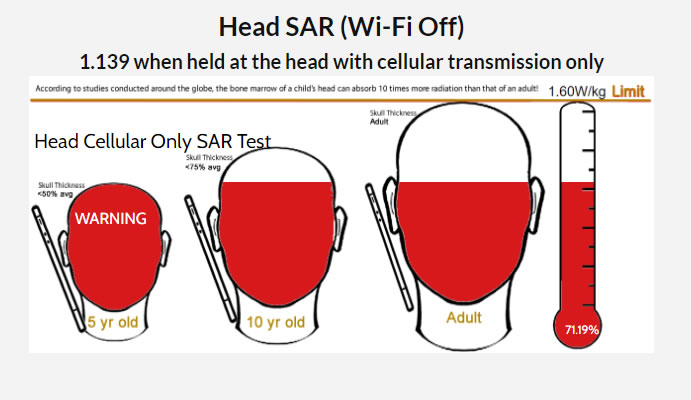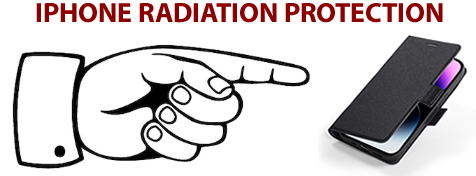The SAR level of a smartphone is a measure of the amount of radio frequency energy that is absorbed by the human body when using a mobile phone. According to the guidelines set by the Federal Communications Commission (FCC), the maximum permissible exposure level is 1.6 W/kg over a volume containing a mass of 1 gram of tissue.
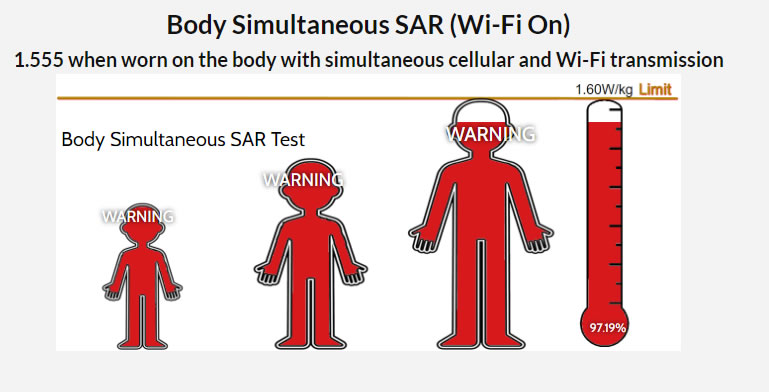
Drawing parallels with the Ford Pinto debacle, where financial gain was put before the safety of consumers, we now scrutinize the recently released iPhone 15 series. The health concerns stemming from the potential repercussions of their SAR levels merit a thorough examination, especially in light of the recent ban on iPhone 12 sales over excessive radiation exposure and the upcoming reassessment by the International Agency for Research on Cancer (IARC) in 2024.
A Brief Overview of the NTP Study
Before delving into the specific SAR levels of the iPhone 15 series, it’s vital to mention the significant National Toxicology Program (NTP) study. This comprehensive study used three different power levels for evaluating the potential health risks of mobile phone radiation, one of which was 1.5 W/kg, marginally lower than the SAR levels reported for the iPhone 15 Pro. The study yielded significant insights into the possible adverse health outcomes associated with prolonged exposure to mobile phone radiation.
A Closer Look at the iPhone 15 Series SAR Levels
Now, let’s critically analyze the reported SAR levels for various models in the iPhone 15 series:
Apple iPhone 15 Pro Max SAR Level Summary:
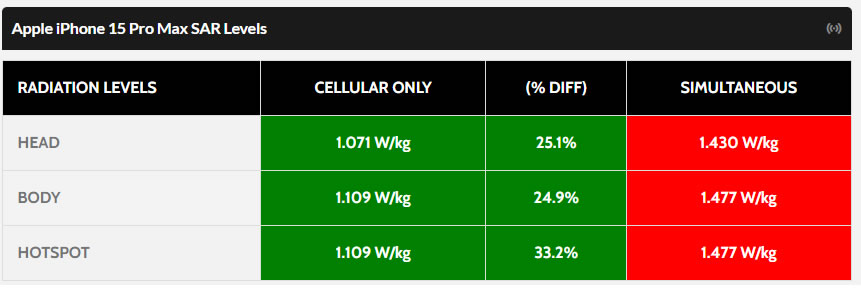 The flagship model in the series, the iPhone 15 Pro Max, reports SAR values that are concerning when juxtaposed against the backdrop of the NTP study. With head and body SAR levels measuring 1.071 W/kg and 1.109 W/kg respectively, and even higher levels during simultaneous transmission involving cellular and Wi-Fi at 1.430 W/kg (head) and 1.477 W/kg (body and hotspot), these values are uncomfortably close to the FCC’s maximum permissible limit. The implications here are manifold – including potential health risks, especially with prolonged usage.
The flagship model in the series, the iPhone 15 Pro Max, reports SAR values that are concerning when juxtaposed against the backdrop of the NTP study. With head and body SAR levels measuring 1.071 W/kg and 1.109 W/kg respectively, and even higher levels during simultaneous transmission involving cellular and Wi-Fi at 1.430 W/kg (head) and 1.477 W/kg (body and hotspot), these values are uncomfortably close to the FCC’s maximum permissible limit. The implications here are manifold – including potential health risks, especially with prolonged usage.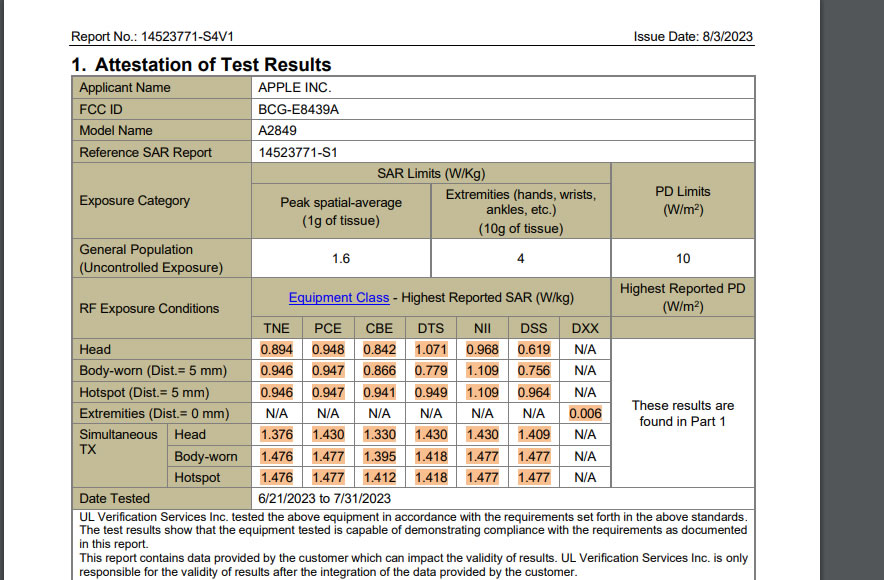
International Version
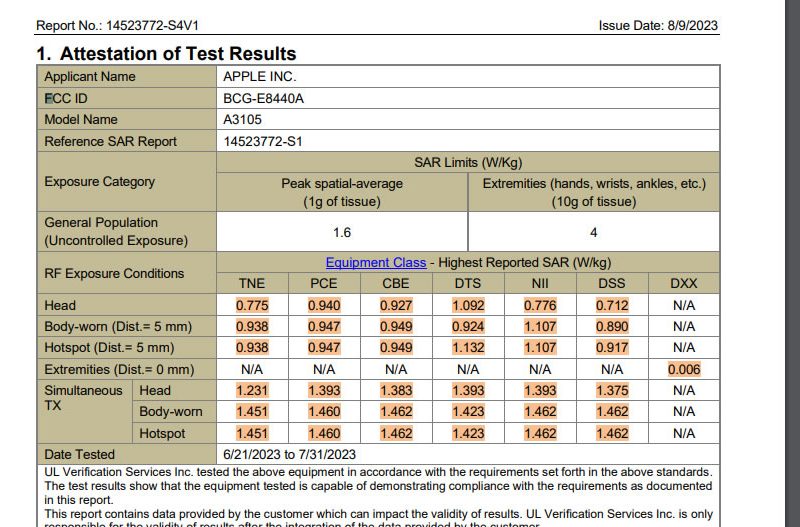
Apple iPhone 15 Plus SAR Level Summary:
Similar to its ‘Pro Max’ counterpart, the iPhone 15 Plus also sports high SAR levels, registering 1.016 W/kg at the head and 1.120 W/kg at the body during cellular transmission. The simultaneous transmission figures are even more alarming, peaking at 1.503 W/kg, which potentially signifies heightened health risks especially during extended periods of multi-transmitter activity.
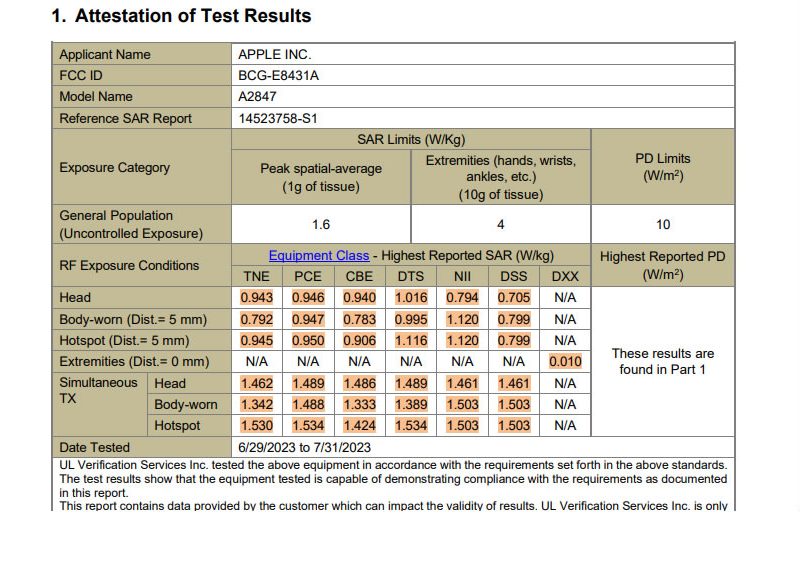
Apple iPhone 15 SAR Level Summary:
The standard iPhone 15 model isn’t far behind, exhibiting SAR levels of 1.121 W/kg (head) and 1.088 W/kg (body) during cellular transmission. The simultaneous transmission scenario mirrors its counterparts, recording levels well above the 1.4 W/kg mark, a statistic that should potentially be viewed with caution, given the growing body of research suggesting possible links between mobile phone radiation and adverse health effects.
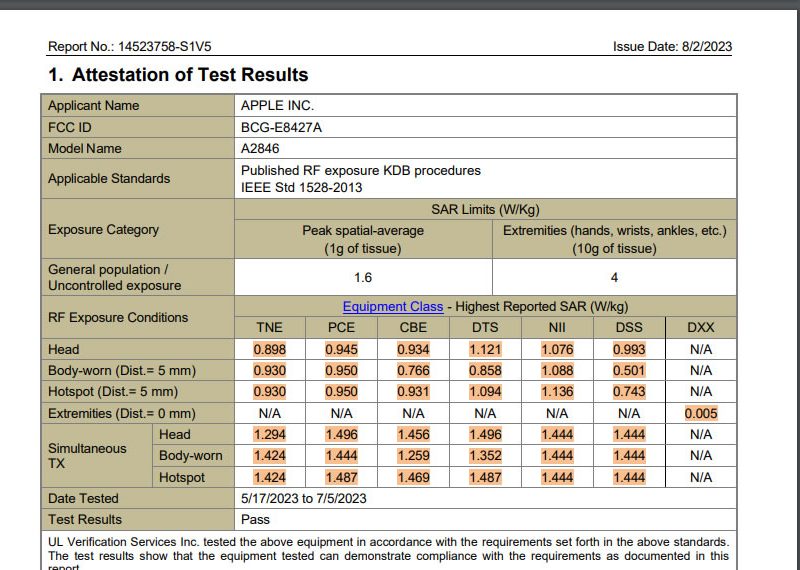
Apple iPhone 15 Pro SAR Level Summary:

The Pro variant of the iPhone 15 series completes a quartet of models with high SAR values, clocking in at 1.139 W/kg (head) and 1.159 W/kg (body) for cellular transmission. The simultaneous transmission figures are highest in the series, peaking at 1.555 W/kg, highlighting a need for careful evaluation and possibly stringent regulatory measures.
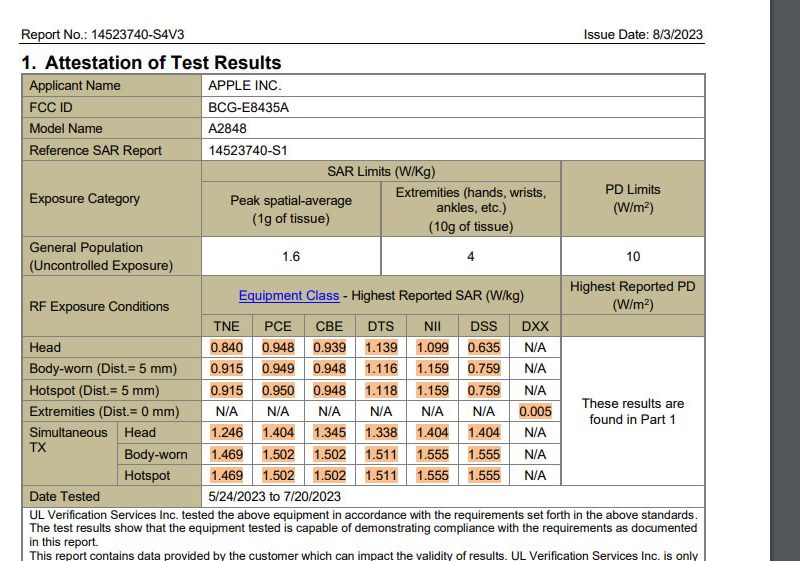
Navigating the Path Ahead
The alarming SAR levels of the iPhone 15 series throw into stark relief the necessity for stringent scrutiny and possibly a recalibration of the existing guidelines set by regulatory agencies. The looming re-evaluation by IARC could potentially redefine the narrative surrounding mobile phone usage and health risks.
Furthermore, it seems essential that consumers are educated on the potential health risks, mirroring the warnings given out by cities like Berkeley. This initiative might also spur developments in technology aiming to reduce SAR levels in smartphones, prioritizing user safety over commercial gains.
Moreover, the industry needs to adopt a transparent approach, where possible adverse health implications are not cloaked under the garb of technological advancements. This scenario mirrors the Ford Pinto case, urging us to ponder – is history repeating itself with different players in a different era?
As consumers, it’s imperative to remain informed and possibly adopt precautionary measures to limit exposure to mobile phone radiation. Meanwhile, the industry should perhaps prioritize safety over profits, steering clear of a path that once led to the infamous recall of Ford Pinto, a glaring example of corporate greed over consumer safety.
As we stand on the cusp of what could be a significant shift in the perception of mobile phone usage, one hopes that the lessons from history serve as a beacon, guiding us to make informed and safe choices. The story of the iPhone 15 series might just be the prologue to a broader narrative that encompasses the well-being of society at large. Let us wait and watch how this narrative unfolds, hopefully steering towards a future that harmonizes technological advancements with the well-being of its users.
It’s been proven that cases that impede the antenna connection to the tower cause the phone to increase radiation. #iphone12 being banned over #sarlevels is a clue of how close all phones are to the legal limit. Beware of detachable anti-radiation phone case designs. Be RF Safe pic.twitter.com/uRkrr5rbHy
— RFSafe (@rfsafe) September 17, 2023

